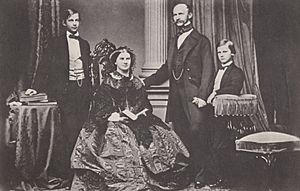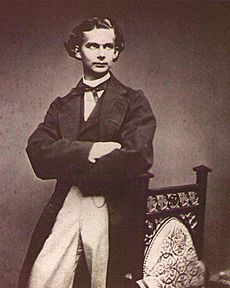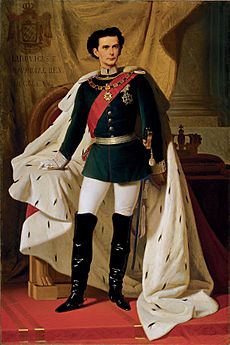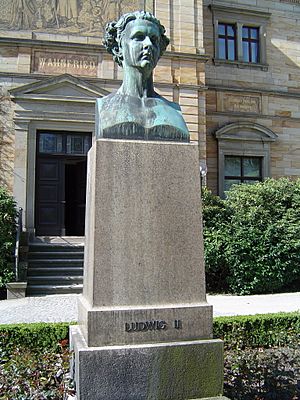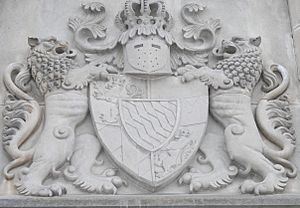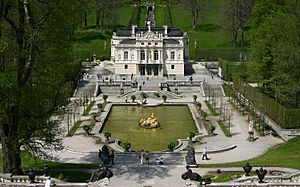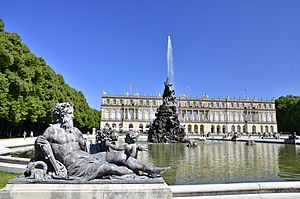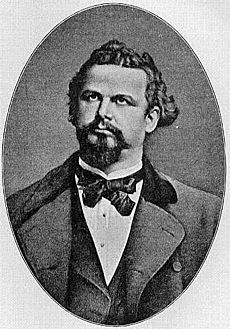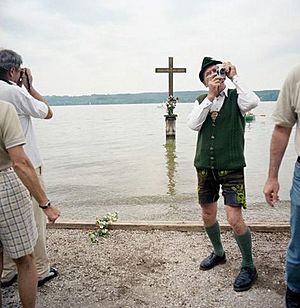Ludwig II of Bavaria facts for kids
Quick facts for kids Ludwig II |
|||||
|---|---|---|---|---|---|
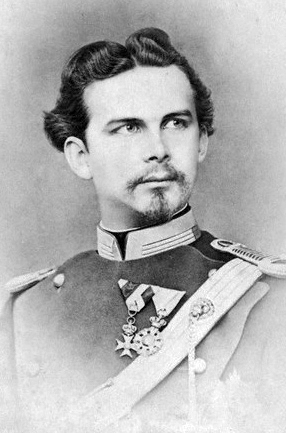
Ludwig, c. 1874
|
|||||
| King of Bavaria | |||||
| Reign | 10 March 1864 – 13 June 1886 | ||||
| Predecessor | Maximilian II | ||||
| Successor | Otto | ||||
| Prime Ministers |
See list
Baron Karl Schrenck von Notzing
Max Ritter von Neumayr Baron Karl Ludwig von der Pfordten Chlodwig, Prince of Hohenlohe-Schillingsfürst Count Otto von Bray-Steinburg Baron Friedrich von Hegnenberg-Dux Adolph von Pfretzschner Johann von Lutz |
||||
| Born | 25 August 1845 Nymphenburg Palace, Munich, Bavaria, German Confederation |
||||
| Died | 13 June 1886 (aged 40) Lake Starnberg, Bavaria, German Empire |
||||
| Burial | St. Michael's Church, Munich | ||||
|
|||||
| House | Wittelsbach | ||||
| Father | Maximilian II of Bavaria | ||||
| Mother | Marie of Prussia | ||||
| Religion | Roman Catholic | ||||
Ludwig II (born Ludwig Otto Friedrich Wilhelm; August 25, 1845 – June 13, 1886) was the King of Bavaria from 1864 until his death. He is often called the Swan King or the Fairy Tale King because of his love for grand castles and stories.
Ludwig became king in 1864 when he was just 18 years old. Two years later, Bavaria fought a short war against Prussia alongside Austria, which they lost. However, in the Franco-Prussian War of 1870, Bavaria joined Prussia and won against France. Even though Ludwig didn't want to, Bavaria became part of the new German Empire in 1871. Wilhelm I, the King of Prussia and Ludwig's cousin, became the first German Emperor. Bavaria still kept some independence within the new Empire.
King Ludwig spent less time on government duties and more on amazing art and building projects. He ordered the building of three incredible palaces: Neuschwanstein Castle, Linderhof Palace, and Herrenchiemsee. He also strongly supported the famous composer Richard Wagner. Ludwig used his own royal money for these projects, borrowing a lot. His ministers tried to stop him, but he didn't listen. This spending was later used to say he was not fit to rule. Ludwig was taken into custody on June 12, 1886, and he and his doctor were found dead the next day. Today, his castles are some of Bavaria's most popular tourist spots.
Contents
Growing Up as a Prince
Ludwig was born at Nymphenburg Palace in Munich. He was the older son of Maximilian II of Bavaria and Marie of Prussia, who became King and Queen in 1848. His grandfather wanted him named Ludwig, after Saint Louis IX of France, who was a patron saint of Bavaria. Ludwig's full name was Ludwig Otto Friedrich Wilhelm. His younger brother, Otto, was born three years later.
As a young prince, Ludwig was always reminded of his royal future. His father wanted both sons to learn about their royal duties early on. Ludwig was given many things but was also strictly controlled by his teachers. He had a tough schedule of studies and exercise. Some people think these pressures made him act unusually when he grew up.
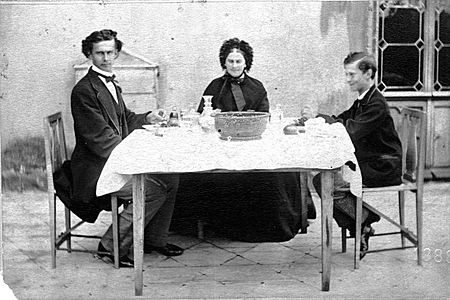
Ludwig was not very close to his parents. He was much closer to his grandfather, the former King Ludwig I.
He spent a lot of his childhood at Hohenschwangau Castle, a fantasy castle his father built near the Alpsee lake. The castle was decorated with paintings showing German heroic stories, especially about Lohengrin, the Knight of the Swans. Ludwig also loved visiting Lake Starnberg. As a teenager, he became good friends with his helper, Prince Paul of Thurn and Taxis. They rode horses, read poetry, and acted out scenes from Richard Wagner's operas. This friendship ended when Paul got engaged in 1866. Ludwig also became lifelong friends with his cousin, Duchess Elisabeth in Bavaria, who later became Empress of Austria.
Becoming King
Crown Prince Ludwig was almost 19 when his father died, and he became King of Bavaria. Even though he wasn't fully ready to rule, his youth and good looks made him popular. He continued his father's policies and kept his ministers.
Ludwig's true passions were art, music, and building. One of his first actions as king was to invite the composer Richard Wagner to his court. He also started building a new Court Theatre in Munich in 1864.
Ludwig was known for being quite unique. He didn't like big public events and preferred to live a quiet life, focusing on his creative projects. He rarely attended military parades or royal banquets. His mother had worried about his shy and artistic nature. These habits caused problems with his government ministers, but the people of Bavaria still loved him. He enjoyed traveling in the countryside and talking with farmers. He was known to give generous gifts to those who were kind to him. In Bavaria, he is still remembered as Unser Kini (meaning 'our cherished king').
Wars and the German Empire
From 1866, the idea of uniting Germany became very important. In the Austro-Prussian War, Ludwig supported Austria against Prussia. Austria and Bavaria lost, and Bavaria had to sign a defense treaty with Prussia. When the Franco-Prussian War started in 1870, Bavaria had to fight with Prussia. After Prussia won against France, Bismarck worked to create a united Germany.
In November 1870, Bavaria joined the North German Confederation, losing its status as a fully independent kingdom. However, Bavaria kept some special rights within the new German Empire. It kept its own diplomats and its own army, which would only come under Prussian command during wartime.
In December 1870, Bismarck convinced Ludwig to write a letter, known as the Kaiserbrief, supporting the creation of the German Empire with King Wilhelm I of Prussia as Emperor. Ludwig was sad about Bavaria losing its independence and refused to attend Wilhelm's ceremony in the Palace of Versailles. Ludwig's brother Otto and uncle Luitpold went instead.
Under the new Imperial Constitution, Bavaria kept many rights, especially concerning its military. The Royal Bavarian army kept its own troops, War Ministry, and military justice system. It also kept its light-blue infantry uniforms and some other unique features. Bavarian soldiers still swore loyalty to the King of Bavaria, not the German Emperor. However, uniforms, equipment, and training became similar to the Prussian style.
Royal Life and Interests
Ludwig never married. He was engaged to his cousin, Duchess Sophie in Bavaria, in 1867. They both loved Wagner's music. Ludwig kept delaying the wedding and finally called it off in October. He wrote to Sophie, using names from Wagner's opera Lohengrin: "My beloved Elsa! Your cruel father has torn us apart. Eternally yours, Heinrich."
After 1871, Ludwig mostly stayed out of politics. He focused on his personal creative projects, especially his castles. He personally approved every detail of their design and decoration.
Ludwig and Richard Wagner
Ludwig was deeply fascinated by the operas of Richard Wagner. This interest began when Ludwig was 15 and first saw Lohengrin. Wagner's operas, full of fantasy, appealed to the young king.
Wagner was known for having many debts. But on May 4, 1864, King Ludwig met Wagner and became his great supporter. Without Ludwig, many of Wagner's later operas might not have been written or performed.
A year after they met, Wagner's opera Tristan und Isolde was performed in Munich and was a big success. However, Wagner's behavior in the city upset many people, and Ludwig had to ask him to leave Munich in December 1865. Ludwig even thought about giving up his throne to follow Wagner, but Wagner convinced him to stay.
Ludwig provided a home for Wagner in Switzerland. Wagner finished Die Meistersinger there, which premiered in Munich in 1868. Ludwig also paid for Wagner's home, Wahnfried villa, built from 1872 to 1874.
Love for Theater
Ludwig's interest in theater went beyond Wagner. He wanted to bring the best European plays to Munich. Under his guidance, plays by Shakespeare, Mozart, and others were performed.
Between 1872 and 1885, the King had 209 "private performances" just for himself or with one guest. He explained that he couldn't enjoy the theater if people were staring at him. He wanted to watch the show, not be the show.
Amazing Castles
Ludwig used his own money to build a series of grand castles. In 1867, he visited the Palace of Versailles in France, which greatly influenced his building style. Ludwig dreamed of making Bavaria's culture as magnificent as France's. These projects gave jobs to many local workers and brought money to poorer areas.
In 1868, Ludwig ordered the first designs for his castles, starting with Neuschwanstein and Herrenchiemsee.
Neuschwanstein Castle
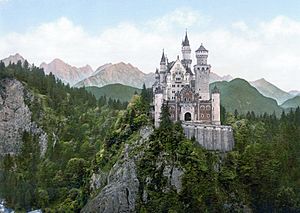
Schloss Neuschwanstein ('New Swanstone Castle') is a dramatic, fairy-tale castle with tall towers. It sits on a mountain cliff above Ludwig's childhood home, Hohenschwangau. Ludwig reportedly imagined building a castle there when he was a boy.
In 1869, Ludwig oversaw the start of Neuschwanstein. The castle walls are decorated with paintings showing scenes from the legends used in Wagner's operas. The castle was not fully finished when Ludwig died. Today, visitors can see the King's living quarters, servant rooms, kitchens, and the grand throne room.
Neuschwanstein Castle is famous worldwide and inspired the Sleeping Beauty Castles at Disney Parks. Millions of tourists visit it every year.
Linderhof Palace
In 1878, Ludwig's Schloss Linderhof was finished. It's an ornate palace in a French Rococo style, with beautiful gardens. The grounds include a Venus grotto (a cave) lit by electricity, where Ludwig would ride in a shell-shaped boat. This was very new technology at the time.
Ludwig also built Hundinghütte ('Hunding's Hut') in the forest near Linderhof, based on a scene from Wagner's opera Die Walküre. He also had a Moroccan House, bought from the Paris World Fair, moved to the park. Inside the palace, the decorations show Ludwig's interest in the old French kings, like Louis XIV of France. Ludwig saw himself as the "Moon King," a romantic version of the "Sun King." From Linderhof, he enjoyed sleigh rides at night in a fancy 18th-century sleigh.
Herrenchiemsee Palace
In 1878, building began on Herrenchiemsee. It was a partial copy of the Palace of Versailles in France, located on an island in the Chiemsee lake. Ludwig built it to honor Louis XIV of France. Only the central part of the palace was built before Ludwig's death. What exists of Herrenchiemsee is still very large and grand. Ludwig only lived there for 10 days in October 1885.
Munich Residence Palace
Ludwig also finished building his royal apartment in the Residenz Palace in Munich. He added a beautiful winter garden on the palace roof. It was a large structure with an ornamental lake, a painted view of the Himalayas, and an exotic tent. The roof was a very advanced metal and glass design. This winter garden was later taken down in 1897.
Other Building Ideas
In the 1880s, Ludwig continued to plan grand projects. He planned a new castle called Falkenstein ('Falcon Rock') near Pfronten. He also thought about a Byzantine palace and a Chinese summer palace, but these were never built.
For Berg Castle, Ludwig added a fifth tower and often used it as his summer home.
The End of His Reign
On June 10, 1886, a government group arrived at Neuschwanstein to tell the King he was no longer fit to rule and to take him into custody. Ludwig had been warned and ordered local police to protect him. The group was turned away. Ludwig then had the officials arrested, but released them a few hours later.
That same day, the government announced that Ludwig's uncle, Luitpold, would be the new Prince Regent. Ludwig's friends urged him to escape or show himself in Munich to get public support. Ludwig hesitated. He issued a statement saying that Luitpold was trying to take over against his will and that his ministers had lied about his health. The government tried to stop this statement from being spread. As the king delayed, his support weakened.
Finally, Ludwig decided to try and escape, but it was too late. Early on June 12, a second group arrived. The King was taken into custody just after midnight and brought to Berg Castle on Lake Starnberg.
His Death
On the afternoon of June 13, 1886, Ludwig went for a walk with his doctor, Dr. Gudden, in the grounds of Berg Castle. They were supposed to be back by 8 pm, but they never returned. After a search, the bodies of both the King and Dr. Gudden were found in the shallow water near the shore of Lake Starnberg at 10:30 pm.
There has been much discussion about how Ludwig died. Some people believe he was murdered while trying to escape. One story suggests he was shot. However, the official report after his death found no wounds on his body. Another idea is that he died from a heart attack or stroke caused by the cold lake water during an escape attempt.
Funeral and Burial
Ludwig's body was dressed in royal clothes and lay in state at the royal chapel in Munich. His funeral was held on June 19, 1886, and he was buried in the Michaelskirche in Munich. However, his heart was placed in a silver urn and sent to the Chapel of Grace in Altötting, following Bavarian tradition.
Three years after his death, a small memorial chapel was built overlooking the spot where his body was found, and a cross was placed in the lake. A ceremony is held there every year on June 13.
Who Ruled Next?
Ludwig was succeeded by his brother Otto. But because Otto was considered too unwell to rule, their uncle Luitpold remained the regent (someone who rules for the king). Luitpold was regent until he died in 1912. His son, also named Ludwig, became regent. This regency lasted until November 1913, when Regent Ludwig removed King Otto and declared himself King Ludwig III of Bavaria. His reign ended with World War I.
Ludwig's Lasting Impact
Many people thought Ludwig was unusual, but whether he was truly mentally ill is still debated. Some experts believe there isn't clear proof he was insane. His cousin and friend, Empress Elisabeth, said, "The King was not mad; he was just an eccentric living in a world of dreams."
One of Ludwig's most famous sayings was, "I wish to remain an eternal enigma to myself and to others."
Today, visitors honor King Ludwig by visiting his grave and, most importantly, his castles. It's interesting that the very castles that caused the king financial problems are now huge tourist attractions for Bavaria. The palaces, given to Bavaria in 1923, have earned back their cost many times over and attract millions of tourists from all over the world each year.
Architecture and Buildings
Ludwig II had a great interest in architecture, just like his grandfather, King Ludwig I, who rebuilt much of Munich. His father also continued building in Munich and built Hohenschwangau Castle, Ludwig II's childhood home. Ludwig II had wanted to build a large opera house in Munich, but the government said no. He later used similar ideas for the festival theater in Bayreuth, built with his own money.
- Winter Garden, Residenz Palace, Munich: This was a very fancy winter garden built on the roof of the palace. It had a lake with gardens and painted scenes. It was covered by an advanced metal and glass roof. It was taken down in 1897 because water leaked from the lake. Photos and drawings still show this amazing creation, which included a cave, a Moorish kiosk, and an Indian royal tent.
- Neuschwanstein Castle: Also called 'New Swan Stone Castle', this dramatic castle has Romanesque, Byzantine, and Gothic styles inside. It was built high above his father's castle, Hohenschwangau. Many wall paintings show scenes from Wagner's operas. The castle was not finished when Ludwig died. The King's living areas, servant rooms, kitchens, and the grand throne room can be visited today. Neuschwanstein Castle is a famous landmark that inspired the Sleeping Beauty Castles at Disney Parks.
- Linderhof Castle: This ornate palace is in a neo-French Rococo style with beautiful gardens. In the park, there's a Venus grotto where Ludwig would ride in a shell-like boat on an underground lake. The lake was lit by electricity, which was very new at the time. Inside the palace, the decorations show Ludwig's interest in the old French kings. Ludwig enjoyed moonlit sleigh rides from Linderhof in a fancy 18th-century sleigh. He sometimes stopped to talk with local farmers, which added to his legend.
- Herrenchiemsee: This palace is a copy of Louis XIV of France's Palace of Versailles in France. It's on an island in the middle of the Chiemsee Lake. Only the central part of the palace was built before the king ran out of money. Ludwig lived there for only 10 days.
- Ludwig also decorated the Schachen king's house with a very detailed Oriental style inside, including a copy of the famous Peacock Throne.
- The Bayreuth Festspielhaus was built for Richard Wagner's operas, with money from King Ludwig.
- Falkenstein: This was a planned, but never built, "robber baron's castle" in the Gothic style. A painting shows it as an even more fairy-tale version of Neuschwanstein, high on a rocky cliff.
Ludwig II left behind many plans and designs for other castles and rooms that were never built. Many of these designs are now in the King Ludwig II Museum at Herrenchiemsee Castle.
Arts and Music

It is often said that Richard Wagner's later career was possible because of Ludwig's support. Wagner likely would not have finished his opera cycle Der Ring des Nibelungen or written his final opera, Parsifal, without the king's help.
Ludwig also paid for the first performances of Wagner's Tristan und Isolde and Die Meistersinger von Nürnberg. He also supported the Bayreuth Festival, where Der Ring des Nibelungen and Parsifal were first performed.
Ludwig also provided Munich with its opera house, Staatstheater am Gärtnerplatz. This created a lasting tradition of comic and romantic musical theater in Bavaria.
Honors and Symbols
 Kingdom of Bavaria: Knight of the Order of St. Hubert
Kingdom of Bavaria: Knight of the Order of St. Hubert Austrian Empire:
Austrian Empire:
- Knight of the Order of the Golden Fleece, 1864
- Grand Cross of the Order of St. Stephen, 1868
 Baden:
Baden:
- Knight of the House Order of Fidelity, 1864
- Grand Cross of the Order of the Zähringer Lion, 1864


 Ernestine duchies: Grand Cross of the Saxe-Ernestine House Order, September 1865
Ernestine duchies: Grand Cross of the Saxe-Ernestine House Order, September 1865 French Empire: Grand Cross of the Legion of Honour, August 1867
French Empire: Grand Cross of the Legion of Honour, August 1867 Kingdom of Hawaii: Grand Cross of the Royal Order of Kamehameha I, 1865
Kingdom of Hawaii: Grand Cross of the Royal Order of Kamehameha I, 1865 Grand Duchy of Hesse: Grand Cross of the Ludwig Order, 7 September 1863
Grand Duchy of Hesse: Grand Cross of the Ludwig Order, 7 September 1863 Kingdom of Italy: Knight of the Order of the Annunciation, 31 May 1869
Kingdom of Italy: Knight of the Order of the Annunciation, 31 May 1869 Mexican Empire: Grand Cross of the Order of the Mexican Eagle, with Collar, 1865
Mexican Empire: Grand Cross of the Order of the Mexican Eagle, with Collar, 1865 Oldenburg: Grand Cross with Golden Crown of the House and Merit Order of Peter Frederick Louis, 4 November 1862
Oldenburg: Grand Cross with Golden Crown of the House and Merit Order of Peter Frederick Louis, 4 November 1862 Kingdom of Prussia: Knight of the Order of the Black Eagle, 24 August 1863; with Collar, 1872
Kingdom of Prussia: Knight of the Order of the Black Eagle, 24 August 1863; with Collar, 1872 Russian Empire: Knight of the Order of St. Andrew, September 1863
Russian Empire: Knight of the Order of St. Andrew, September 1863 Saxe-Weimar-Eisenach: Grand Cross of the Order of the White Falcon, 14 September 1864
Saxe-Weimar-Eisenach: Grand Cross of the Order of the White Falcon, 14 September 1864 Kingdom of Saxony: Knight of the Order of the Rue Crown, 1864
Kingdom of Saxony: Knight of the Order of the Rue Crown, 1864 Spain: Grand Cross of the Order of Charles III, with Collar, 5 April 1864
Spain: Grand Cross of the Order of Charles III, with Collar, 5 April 1864
 Sweden-Norway: Knight of the Order of the Seraphim, 9 April 1864
Sweden-Norway: Knight of the Order of the Seraphim, 9 April 1864 Württemberg: Grand Cross of the Order of the Württemberg Crown, 1864
Württemberg: Grand Cross of the Order of the Württemberg Crown, 1864
|
See also
 In Spanish: Luis II de Baviera para niños
In Spanish: Luis II de Baviera para niños


